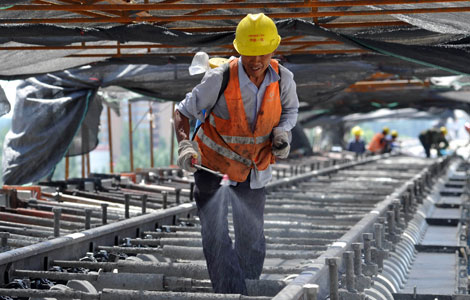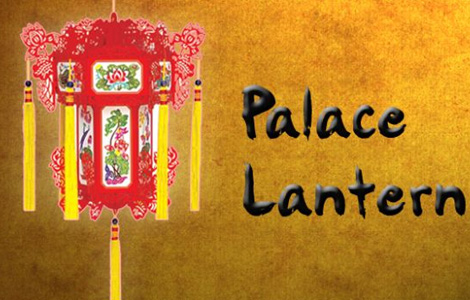Serving time with performance art
Updated: 2013-07-12 13:31
By Lance Crayon (chinadaily.com.cn)
|
|||||||||||
Hsieh's work has appeared at both the Museum of Modern Art (MoMA) and the Guggenheim in New York City, and was featured at the 2010 Liverpool Biennale Festival of Contemporary Art in 2010.
From 1978 to 1986 Hsieh completed five one-year performance art works in New York City. His first performance piece saw him living in a cage in his studio for one year. His second performance, Time Clock Piece, consisted of him punching a time clock on the hour every hour for one year, and it's this work that is now on display at the Ullens Center for Contemporary Art (UCCA) in the 798 arts district.
UCCA director Philip Tinari told China Daily, "We thought this piece was the most visually compelling and also the most direct distillation of his whole artistic outlook which is very much about time and the idea that life is a life sentence."
Earlier this year the US art and culture magazine Complex featured the 25 Best Performance Art Pieces of All Time, and Hsieh’s Time Clock Piece was listed at #11.
Hsieh lives in New York City and retired from producing art in 2000. The media-shy artist declined an email interview request and instead referred China Daily to an interview conducted by Adrian Heathfield as part of the book Perform, Repeat, Record: Live Art in History.
In the Heathfield interview Hsieh said his main influences were Dostoyevsky, Kafka, Nietzsche, Sisyphus, contemporary art and his mother. When addressing his work he said, "To get the message of my art, an audience's presence is not vital. As long as audiences know my concept and the real action I did, they can use their own experiences and imagination to feel these artworks."
Limited public access while he performed his work could be one reason why he received such word-of-mouth notoriety as it was happening and afterwards, because many were not able to witness it. When performance art in China began to take off in the 1990's, his work was heavily influential on mainland artists then just as much as it is now.
Tinari said, "His work in the last five years has undergone not a reassessment because it's always been highly regarded by people in the art world, but it's undergone an immense popularization as institutions start to think more about art from Asia and as institutions in Asia start to think more about the history of contemporary art."
The exhibition covers a room with photos and time cards. The first photo shows Hsieh with a clean-shaven head dated April 11, 1980, and the last photo shows him with long hair dated April 11, 1981. At the top of each strip of photos is a time card showing the times when he punched the clock each day.
Another feature of the exhibit consists of a six-minute video made up of one photo of Hsieh taken every day during the performance. Each photo takes up one second of time and traces the artist’s physical transformation over the course of the project. The video can be challenging to watch from start to finish but it gives the viewer a taste of the brevity of this boundary-pushing work.
Regarding Time Clock Piece Hsieh has said, "In one hour I could not do much, my mind and my body have to be totally concentrated on time. Even if I were talking to someone I would be thinking, ‘I have to go and punch the time clock.’ I could not miss that. I couldn’t use my energy too much."
It's an extreme way to get people to think about time, but extremity is oftentimes the cornerstone of performance art. Sometimes the action rather than the message serves as the genre's greatest detractor while at the same time functioning as its main attraction.
Some well-known examples include Joseph Beuys talking to a dead animal for his piece Explaining Pictures to a Dead Hare to Carolee Schneemanns’s Meat Joy which featured dancing performers covered with raw meat and paint, and then there’s US artist Chris Burden who had his assistant shoot him in the arm at close range with a handgun for his performance piece Shoot.
"Among all of the artworks I know of, this one tests the willpower of the artist the most, said Bao Dong, an independent curator in Beijing.
Bao told China Daily, "As a Chinese artist, his influence reached the mainland at a very early age and it had a stimulating influence on the development of China’s performing arts in 1990's."
Since the 1990s performance art in China has made rapid advancements. "This work in particular has been influential on Chinese artists for the last twenty years ever since it was introduced to the mainland artistic community in the early 90’s and so we thought for that reason it would be quite interesting to finally bring it (Time Clock Piece) here and show it in all it’s glory," said Tinari.
Hsieh's work has been shown on the Chinese mainland before, but this is the first time it has been presented in a solo format rather than as part of a group show.
Tinari is optimistic regarding how Hsieh's work will be received in Beijing. "I hope this exhibition will be comprehensible to its audience and on the level of the art world, and I hope that people will be happy to finally have a chance to see something they've been hearing about for twenty years," Tinari added.
Time Clock Piece ends August 25.
Today's Top News
Top GSK executives probed in bribery
Coal mine found concealing blast death toll
A dream home helps build the future
Masks reveal unknown worlds
Shelter to help abandoned children
Lifesaving top priority, premier says
Pathfinder pianist
Villagers excited to meet President Xi
Hot Topics
Lunar probe , China growth forecasts, Emission rules get tougher, China seen through 'colored lens', International board,
Editor's Picks

|

|

|

|

|

|





